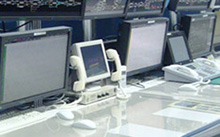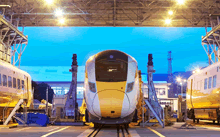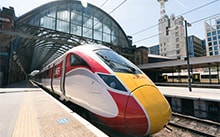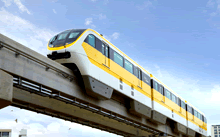Tokyo Metro Co., Ltd., a subway company with a ridership of as many as 7.42 million passengers a day, provides safe and on-time train operation with a highly dense timetable. To further enhance convenience for train users, in 2013, Tokyo Metro decided to offer reciprocal through-service operated by five railway companies. Prior to system implementation, Tokyo Metro and Hitachi set out on improvements to the operation control system that would both maintain a regular schedule during reciprocal through-service and enable a rapid response to schedule disruptions.
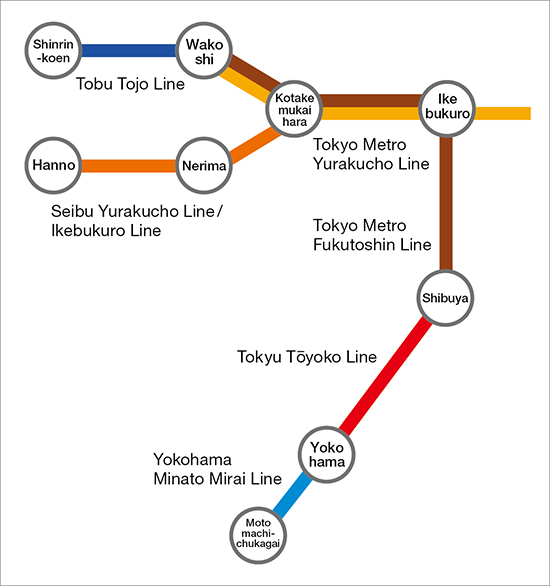
Route map of the 5 Railways Reciprocal Through-Service
Tokyo Metro is a railway operator that runs nine separate train lines in the Tokyo area totaling over 195.1 km* of track. The actual operation of these lines is the task of the transit controllers at the Integrated Control Center, where their work is assisted by an operation control system. This system automatically controls trains so that they run on-time following a previously established schedule. If the schedule is disrupted by some kind of incident, such as an accident, the system then controls train operation in accordance with schedule changes that controllers have made to adapt to the situation, such as the limiting of train operation to certain sections or the temporary suspension of reciprocal through-service.
In 2013, Tokyo Metro launched the 5 Railways Reciprocal Through-Service comprising a network of six railway lines operated by five railway companies. These include Tokyo Metro (covering 2 of its 9 lines, the Yurakucho Line and Fukutoshin Line), the Tokyu Railway, the Tobu Railway, the Seibu Railway, and the Yokohama Minatomirai Railway. This system allows mutual access by the cars of these five railways to each of their operational sections. Although it increases rider convenience through such features as train-change-free access to Tokyo's city sub-centers, the project also forecast the risk of a schedule disruption at a single location rippling extensively throughout the network. Aiming to resolve this issue, Hitachi began working with Tokyo Metro on improving and updating the existing operation system before service implementation in 2010.
As the link connecting the other railway lines, the two Tokyo Metro lines (Yurakucho Line and Fukutoshin Line) are critical to adjusting operations if a schedule disruption occurs in the 5 Railways Reciprocal Through-Service. Improvements to the operation system therefore involved various improvements and functional enhancements to the hardware and software used at the Integrated Control Center, where operational control is conducted, in order to maintain safe and stress-free train operation and to enable controllers to respond immediately in emergency situations.
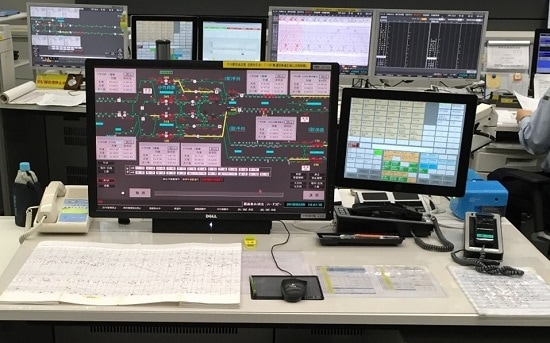
Manual terminal designed especially for Kotakemukaihara Station
The hardware received three main improvements. The first was the replacement of the central processing unit, the backbone of the system, with a high-performance unit. This yielded higher processing and reaction speeds in system management, schedule management, and other aspects of operational control.
The second was the improvement of the command entry terminal. The previous system had one monitor per person for command work. Because of the consequent need for frequent switching between screens and the effect this had on service restoration work, a multi-monitor system was set up that gave two monitors to each controller. Another issue was the difficulty in providing a rapid event response upon a schedule disruption due to having to give operational adjustment instructions by radio, which could only be accomplished one communication per train line. To enable rapid restoration, a new terminal equipped with a touch panel that can immediately send instructions from the station's display to train crew and station personnel was installed.
The third was dealing with the projected increase in schedule disruptions at Kotakemukaihara Station, a junction station servicing lines out to four directions. A manual terminal designed especially for Kotakemukaihara Station was installed, and controllers were assigned especially to the rush hours. These measures made it possible to prevent train confusion at Kotakemukaihara Station and to smoothly carry out manual control in the event of a disruption so as to rapidly restore normal service.
The software received functional enhancements for improving the ability to respond to schedule disruptions. First, a schedule-change function was added that supplies directions for operational adjustment in four phases, “halt of service in progress”, “substitution of all at one time”, “simple substitution”, and “through-operation halt,” in accordance with the problem-causing section, the cause, and other relevant factors. Assistance functions were enhanced by enabling monitors to display information for both the Tokyo Metro lines for trains running on the lines of other railways and by adding a schedule and train search function for finding the current position of a delayed train. These enhancements streamlined control operations by giving controllers the ability to rapidly ascertain operational status.

Command console designed into a “V” configuration based on test-verification results
Another area targeted for improvement was the command environment at the Integrated Control Center. To accomplish this, Experience Oriented Approach, Hitachi's proprietary method for the collaborative creation of value, was adopted. This method seeks to discover, share, and find solutions to issues together with customers through interactions and exchanges with designers, engineers, and other stakeholders, whose points of view all differ.
After observing and investigating the bustling activity of 10 controllers around the command console in an emergency situation, interviews were conducted that also brought in people in charge of other sections. The results were then applied to the reduction of even one second of waste from the various personnel movements with a view toward achieving service restoration that is faster by even a single second. Hitachi and its customer also pursued ergonomics-based ease of use by using a full-scale mockup of the command console to reproduce actual personnel movements testing and verifying in units of millimeters such command console parameters as placement and height, the positional relationship between controller and monitor, and others.
Going through this process made it possible for Hitachi and Tokyo Metro to tackle such issues as difficulties in communications between controllers and the poor visibility of the operation display board located in front of the command console, solving them by placing equipment and devices in positions optimal for use by controllers and by designing a command console bent into a “V” shape, whose point is at the center of the table. (See figure at right.)
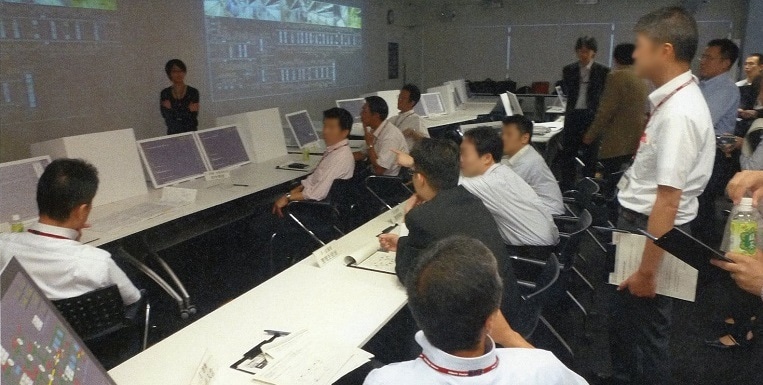
Testing and verification conducting by reproducing controller movements using a full-scale mockup of the command console
This was the path leading to the March 2013 startup of the 5 Railways Reciprocal Through-Service, the culmination of new improvements to the operation control system. By connecting such districts outside of Tokyo as Minatomirai in Kanagawa Prefecture and Kawagoe and Hanno in Saitama Prefecture, this system enhances the convenience of train users on their various errands, from commuting to work and school to shopping and sightseeing, by making it possible to access the various Tokyo sub-centers of Shibuya, Shinjuku, and Ikebukuro without having to change trains.
Tokyo Metro is currently in the process of implementing this operation control system on all its lines. As a partner in this process, Hitachi has worked together with Tokyo Metro on various service enhancements aimed at dealing with changes to operations, including increasing the number of trains in service and extending their service sections.
With the aim of contributing to the creation of train systems that provide a safe and comfortable experience for their users, in the future, Hitachi will apply its Experience Oriented Approach to the operation control systems of other railway companies through collaborative creation with customers to develop highly reliable, convenient systems and proposals for ideal operational environments amenable to use by all train controllers.
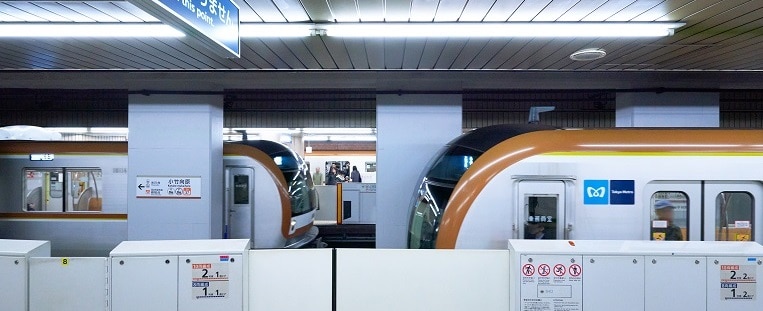
Release Date: March 2019
Solutions By: Railway Systems Business Unit, Hitachi, Ltd.
